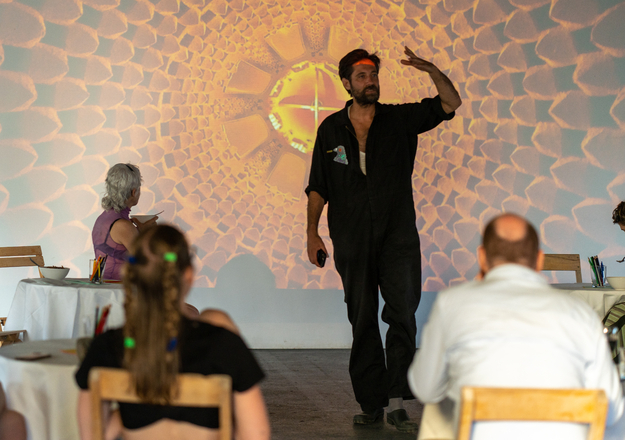The conversation began with an introduction by artist Arne Hendriks, co-curator of the Talks with Clemens Driessen. Arne introduced the attendees to the idea behind these monthly events and the goal of using mycelium-waste-pigeon-towers as teachers for new learning and awakening. Arne’s living towers, which have been constructed around Mediamatic’s Biotoop since 2020, are a complex system in which the lives of several organisms, including fungi, pigeons, plants, insects, and many others, are intertwined in co-dependent relationships. Arne explains how with his project he challenges people not to create something perfect but rather something to draw lessons from.
For years, Debra Solomon has been immersed in the realm of public space, dedicating her practice to fostering dynamic interactions among humans and various non-human entities. Central to her research is the transformation of urban environments into vibrant food forests, wherein the existing landscape is reimagined as abundant ecosystems that provide nourishment and sustenance.
Giving the urgency of the times, Debra explains how it is now an imperative to be political in our creative practices and proposals. The urban space cannot ignore the drastic and alarming changes that are currently going on. With her organization Urbaniahoeve, Debra hence proposes a deconstruction, envisioning a different format to maintain public space in the Netherlands. When a space is maintained differently, there are suddenly more species visible, which is inspiring and demonstrates how, if we overcome the aesthetic of orderliness typical of urban greens and replace it with one of messiness, everything can become more positively productive for humans and other-than-humans alike. Alternatives to the notion of urban landscapes as sterile, unproductive fields should be developed, with the understanding that messy does not mean neglected, but rather left free and less controlled.
The ever-evolving living towers, built with live mycelium, a medium that can never be fully controlled and that is endowed with an agency of its own, offer an opportunity on how to envision a less enclosed public space. Undoubtedly, there is still much work ahead, particularly in the political domain. However, the objectives that have been set and the enthusiasm ignited by the discussion are highly promising. We are committed to nurturing and cultivating these positive developments, ensuring that they flourish and drive meaningful change.


